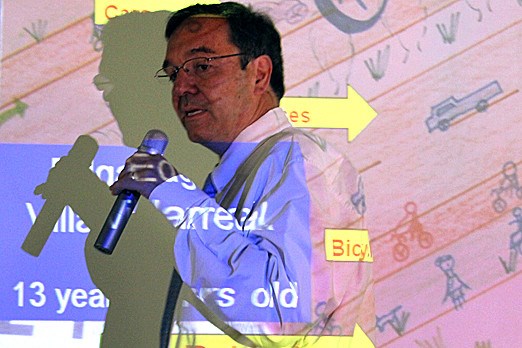Cold weather shouldn’t put active living on ice.
That’s a message 8-80 Cities executive director Gil Penalosa brought to a crowd that packed a conference room at the Prince Arthur Hotel for an early breakfast Thursday. With coffee and toast in hand, that crowd heard presentations about the WalkON, an initiative that aims to make Thunder Bay a more active community.
It isn’t rocket science to make a city more welcoming to those who want to go for a stroll or ride a bike, Penalosa said. Even the cold winters that frequent Thunder Bay shouldn’t stop people from being active, because in the end it is just a case of mind over matter.
"The winter issue is more of a mental issue," Penalosa said. "Our Danish friends say there’s no such thing as bad weather but there’s bad clothing. I think if we use the proper clothing, I think things are pretty much OK.
“In Thunder Bay, the amount of snow per year is less than my height and it’s over five months. So it’s not much. So it is more of a mental issue."
Penalosa said there’s a misconception that cities should be built with the mindset that its residents are 30 years old and in good shape. That didn’t fit his definition of a city that’s made up of children and seniors.
If paths are accessible only by driving to it, then it defeats its purpose. But that’s just one area that needs improvement, as sidewalks also need to be more accessible and people need incentives to go outside more, he said.
Each city is unique and so the same method for Thunder Bay may not fit for a city that’s larger or smaller.
"Thunder Bay is unique, every community is unique," he said. "There’s no computer model. It’s all about adapting and improving. We get these ideas from different places in order to build healthier communities."
He added that it was interesting to note that people work to pay off their cars when they could have saved that money and taken a trip to Europe.
Thunder Bay has already taken steps to try to make roads friendlier for cyclists. The city implemented its first bike lane on Court Street nearly a year ago.
Stasia Starr, a public health nurse with the Thunder Bay District Health Unit, said the creation of the bike paths is a step in the right direction.
"There’s many health benefits associated with walking and biking," Starr said. "We have become a culture where the car is the most obvious choice for people when they’re moving about in their environment.
“If we can encourage people to get out of their cars and use their bodies to go to work, do their errands or take their children to school, we will all be a healthier population."
Thunder Bay Mayor Keith Hobbs also attended the breakfast and said he thought that it was plausible to make Thunder Bay more active and mobile.
The mayor added that he didn’t like the bike lane idea and wanted them moved to an isolated location so it didn’t impede traffic.
"I’m not a big fan of the bike trails on the streets," Hobbs said. "We’re working on biking routes and a trail system. I would like to see the whole city connected. There’s some great trails at Confederation College and Lakehead University and the Westfort area and we need to connect them."
Sign in or register
- Messages
- Post a Listing
- Your Listings
- Your Profile
- Your Subscriptions
- Your Likes
- Your Business
- Support Local News
- Payment History
Registered Users
Already have an account?
New Users
Create a free account.
